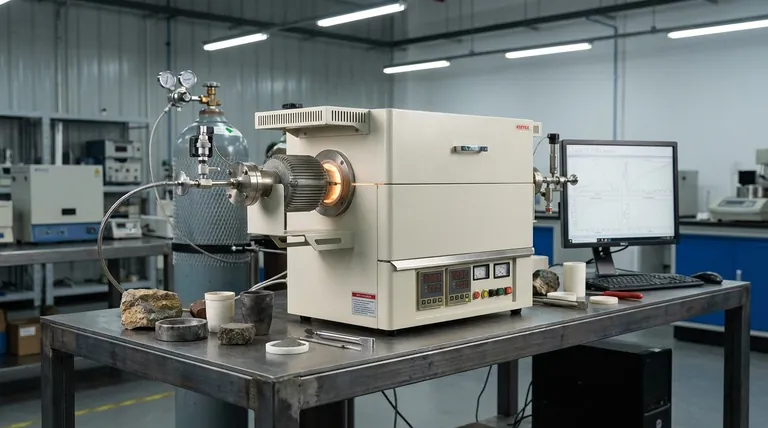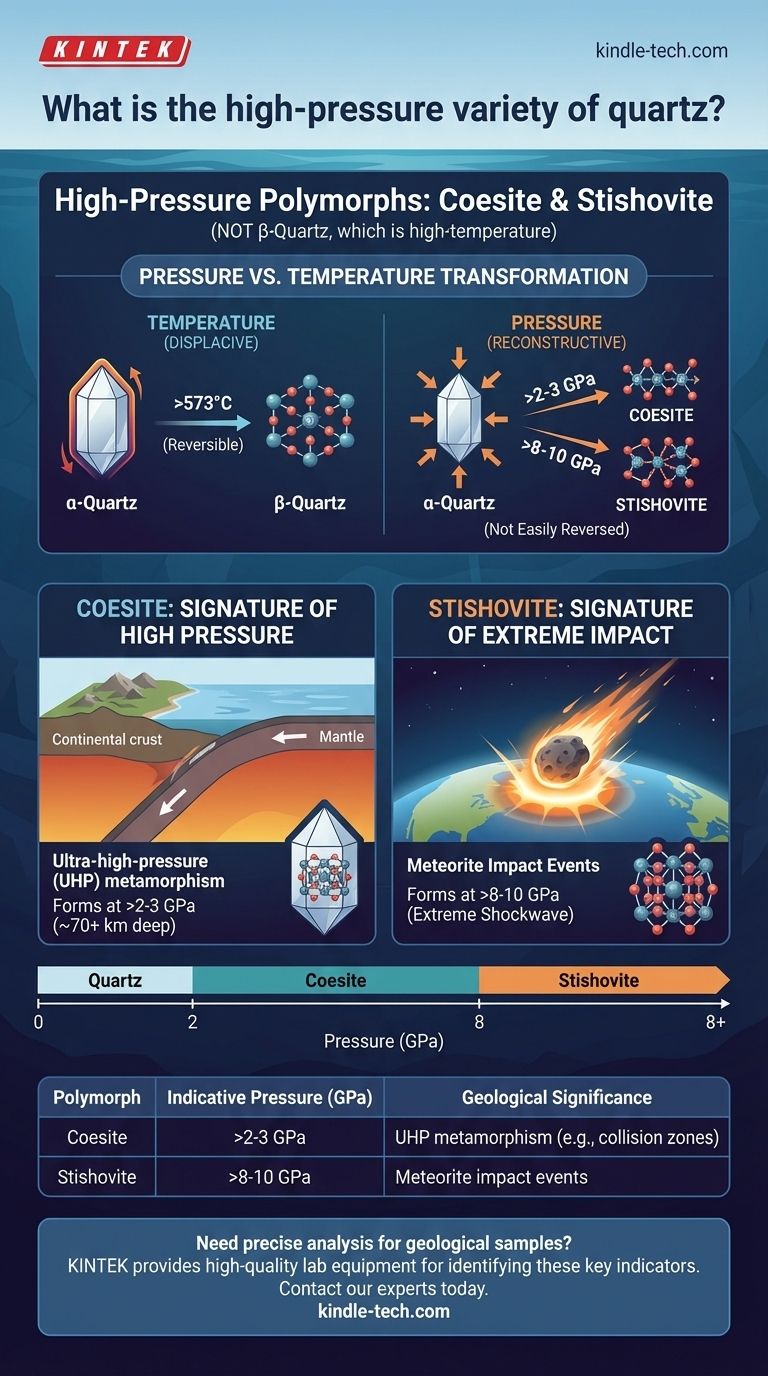In short, the primary high-pressure polymorphs of quartz (SiO₂) are Coesite and Stishovite. It is a common point of confusion, but "high quartz" or β-quartz is a high-temperature form, not a high-pressure one. Both pressure and temperature independently force the silicon dioxide molecule into different crystal structures.
The form quartz takes is not static; it is a direct reflection of the pressure and temperature conditions under which it formed. Understanding these different forms, or polymorphs, allows us to decipher the history of rocks from deep within the Earth or from meteorite impacts.

Differentiating Pressure vs. Temperature Effects
The most critical concept to grasp is that pressure and temperature are two separate forces that cause different transformations in the SiO₂ crystal lattice.
The Temperature Transformation: α-Quartz and β-Quartz
The term "high quartz" refers to β-quartz (beta-quartz), a polymorph that forms from common α-quartz (alpha-quartz) at temperatures above 573° C at surface pressure.
This is a displacive transformation. The overall crystal structure remains, but the atoms shift their positions slightly. This change is reversible; as β-quartz cools, it immediately reverts back to α-quartz.
The Pressure Transformation: Coesite and Stishovite
Applying immense pressure forces a much more dramatic change. It causes a reconstructive transformation, where atomic bonds are broken and reformed into a denser, more compact structure.
These changes require enormous pressure and are not easily reversed, effectively locking a record of that pressure into the mineral.
The True High-Pressure Polymorphs
When geologists find Coesite or Stishovite, they know the rock has experienced extreme conditions not found at the Earth's surface.
Coesite: The Signature of High Pressure
Coesite forms at pressures above 2-3 gigapascals (GPa), equivalent to the pressure found at depths of over 70 km in the Earth's crust.
Its structure is significantly denser than quartz. The presence of coesite is a key indicator of ultra-high-pressure (UHP) metamorphism, often associated with continental collision zones where crustal material is subducted deep into the mantle.
Stishovite: The Signature of Extreme Impact
At even more extreme pressures, typically above 8-10 GPa, Stishovite is formed. These conditions are rarely achieved through tectonic processes on Earth.
Stishovite is an exceptionally dense polymorph where each silicon atom is bonded to six oxygen atoms instead of the usual four. Its presence is considered definitive proof of a meteorite impact, as the shockwave from an impact is one of the few natural events capable of generating such immense pressure.
Understanding the Geological Significance
The existence of these polymorphs is not just a scientific curiosity; it is a fundamental tool for interpreting a rock's history. They serve as reliable geological pressure gauges.
Minerals as Geobarometers
Because each polymorph is stable only within a specific pressure-temperature range, finding one of them tells a geologist the minimum pressure the host rock must have endured.
This allows for the reconstruction of powerful geological events from the past, turning a simple mineral into a story of mountain-building or extraterrestrial impact.
Indicators of Geodynamic Processes
The discovery of coesite fundamentally changed our understanding of plate tectonics, proving that continental crust could be subducted to great depths and then return to the surface.
Similarly, stishovite found at sites like Meteor Crater in Arizona provides undeniable evidence of an impact event, settling debates about the origin of such features.
Applying This Knowledge
Your interpretation of these minerals depends on your goal.
- If your primary focus is mineralogy: Your key takeaway is that quartz is just one member of the SiO₂ polymorph family, with Coesite and Stishovite representing its high-pressure forms.
- If your primary focus is geology or petrology: Your key takeaway is that Coesite and Stishovite are powerful diagnostic tools that serve as definitive indicators of ultra-high-pressure metamorphism and meteorite impacts, respectively.
Ultimately, a single chemical formula, SiO₂, tells a profound story about the immense forces that shape our planet.
Summary Table:
| Polymorph | Indicative Pressure (GPa) | Geological Significance |
|---|---|---|
| Coesite | > 2-3 GPa | Ultra-high-pressure metamorphism (e.g., continental collision) |
| Stishovite | > 8-10 GPa | Meteorite impact events |
Need precise analysis for geological samples?
Understanding mineral polymorphs like Coesite and Stishovite is crucial for accurate geological interpretation. KINTEK specializes in supplying high-quality lab equipment and consumables for demanding geological and petrological research. Our products support the precise sample preparation and analysis needed to identify these key indicators.
Let us equip your lab to uncover the Earth's history. Contact our experts today to discuss your specific laboratory needs.
Visual Guide

Related Products
- High Pressure Laboratory Vacuum Tube Furnace Quartz Tubular Furnace
- Laboratory Quartz Tube Furnace Tubular RTP Heating Furnace
- 1200℃ Split Tube Furnace with Quartz Tube Laboratory Tubular Furnace
- Vacuum Heat Treat and Sintering Furnace with 9MPa Air Pressure
- 1700℃ Laboratory Quartz Tube Furnace with Alumina Tube Tubular Furnace
People Also Ask
- What is a tubular furnace used for? Precision Heating for Material Synthesis & Analysis
- Can you get an electrical arc in vacuum? How High Voltage Creates Plasma in a Void
- What is the difference between a tubular furnace and a muffle furnace? Choose the Right Tool for Your Application
- What is a vacuum tube furnace? Achieve Purity and Precision in High-Temperature Processing
- Which type of furnace can create high temperature? Choose Between Tube and Box Furnaces



















